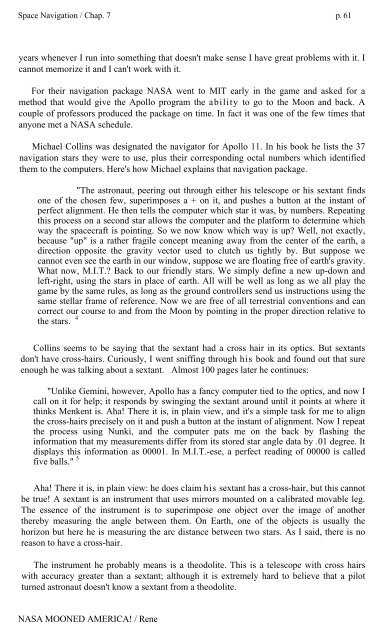Rene-NASA-Mooned-America
Rene-NASA-Mooned-America
Rene-NASA-Mooned-America
Create successful ePaper yourself
Turn your PDF publications into a flip-book with our unique Google optimized e-Paper software.
Space Navigation / Chap. 7 p. 61<br />
years whenever I run into something that doesn't make sense I have great problems with it. I<br />
cannot memorize it and I can't work with it.<br />
For their navigation package <strong>NASA</strong> went to MIT early in the game and asked for a<br />
method that would give the Apollo program the ability to go to the Moon and back. A<br />
couple of professors produced the package on time. In fact it was one of the few times that<br />
anyone met a <strong>NASA</strong> schedule.<br />
Michael Collins was designated the navigator for Apollo 11. In his book he lists the 37<br />
navigation stars they were to use, plus their corresponding octal numbers which identified<br />
them to the computers. Here's how Michael explains that navigation package.<br />
"The astronaut, peering out through either his telescope or his sextant finds<br />
one of the chosen few, superimposes a + on it, and pushes a button at the instant of<br />
perfect alignment. He then tells the computer which star it was, by numbers. Repeating<br />
this process on a second star allows the computer and the platform to determine which<br />
way the spacecraft is pointing. So we now know which way is up Well, not exactly,<br />
because "up" is a rather fragile concept meaning away from the center of the earth, a<br />
direction opposite the gravity vector used to clutch us tightly by. But suppose we<br />
cannot even see the earth in our window, suppose we are floating free of earth's gravity.<br />
What now, M.I.T. Back to our friendly stars. We simply define a new up-down and<br />
left-right, using the stars in place of earth. All will be well as long as we all play the<br />
game by the same rules, as long as the ground controllers send us instructions using the<br />
same stellar frame of reference. Now we are free of all terrestrial conventions and can<br />
correct our course to and from the Moon by pointing in the proper direction relative to<br />
the stars. 4<br />
Collins seems to be saying that the sextant had a cross hair in its optics. But sextants<br />
don't have cross-hairs. Curiously, I went sniffing through his book and found out that sure<br />
enough he was talking about a sextant. Almost 100 pages later he continues:<br />
"Unlike Gemini, however, Apollo has a fancy computer tied to the optics, and now I<br />
call on it for help; it responds by swinging the sextant around until it points at where it<br />
thinks Menkent is. Aha! There it is, in plain view, and it's a simple task for me to align<br />
the cross-hairs precisely on it and push a button at the instant of alignment. Now I repeat<br />
the process using Nunki, and the computer pats me on the back by flashing the<br />
information that my measurements differ from its stored star angle data by .01 degree. It<br />
displays this information as 00001. In M.I.T.-ese, a perfect reading of 00000 is called<br />
five balls." 5<br />
Aha! There it is, in plain view: he does claim his sextant has a cross-hair, but this cannot<br />
be true! A sextant is an instrument that uses mirrors mounted on a calibrated movable leg.<br />
The essence of the instrument is to superimpose one object over the image of another<br />
thereby measuring the angle between them. On Earth, one of the objects is usually the<br />
horizon but here he is measuring the arc distance between two stars. As I said, there is no<br />
reason to have a cross-hair.<br />
The instrument he probably means is a theodolite. This is a telescope with cross hairs<br />
with accuracy greater than a sextant; although it is extremely hard to believe that a pilot<br />
turned astronaut doesn't know a sextant from a theodolite.<br />
<strong>NASA</strong> MOONED AMERICA! / <strong>Rene</strong>


